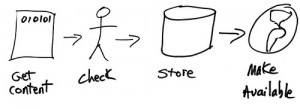Much of the work in archival processing, documentary editing, exhibition and digitization involves spending a lot of time doing a series of tasks one after another with the end goal of “the big thing.” At the end there is finding aid and a collection available to researchers, or a volume of edited manuscripts or a large exhibition. I’ve been increasingly thinking that it’s in our best interest to make these into smaller discrete products that would come at varying degrees of polish and finish.
Elsewhere I’ve suggested that it’s in the best interest of cultural heritage organizations to start doing less and doing it more often. That is turn out smaller work products on a regular basis. Short blog posts, description of items as they are done, etc. I still think that is important. With that said, I’ve seen a lot of situations where there are significant bottlenecks in attempting to do this work in serial, when much of it could happen in parallel and help get more of the stuff of digital collections out there and potentially create opportunities for members of the public to help out.
For example, I know of one organization that insists on doing item level description for every item they digitize. The result is that there is a massive bottleneck in cataloging. So why not just digitize things with minimal collection level metadata and let other folks describe.
So I’d be interested in thinking through this with anyone else interested. Specifically I’d imagine
- Sharing a few example workflows for digital collection/exhibition projects at different organizations
- Picking one or two that the group thinks to be generally interesting and making diagrams of them to identify bottlenecks
- Thinking through and sketching out how we could make them turn out more frequent smaller products and get more of the work happening in parallel.





It’s funny: I just had GMU’s archivist talk to my class, and she pointed to the speedup in description as a big change in archives management over the course of her career. But that’s a generality, of course, and it’d be great to get a specific model for a fast workflow.
This session seems like a good companion to the one I proposed on Participatory DH.